The Indiana Company, Grand Ohio Company, and Vandalia
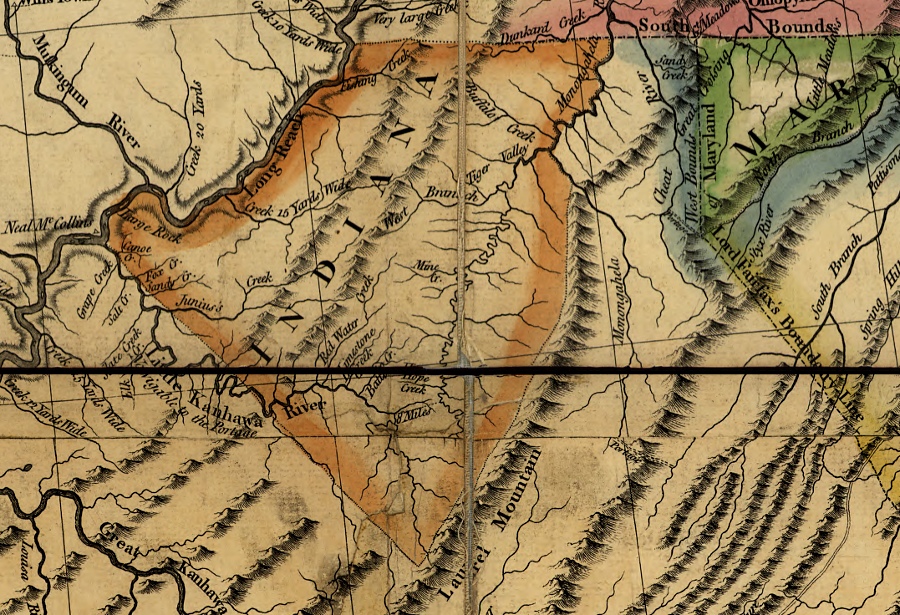
the "suffering traders" affected by Pontiac's War obtained the Indiana Grant as compensation
Source: Library of Congress, A new map of the western parts of Virginia, Pennsylvania, Maryland, and North Carolina; comprehending the River Ohio, and all the rivers, which fall into it (Thomas Hutchins, 1778)
The start of the French and Indian War blocked the Greenbrier, Loyal, and Ohio companies and other land speculators from selling parcels from their grants in the Ohio River watershed.
Sale of western lands were frozen after the British victory when George III issued the Proclamation of 1763. That proclamation was a response to Pontiac's Rebellion, where Native Americans united to resist British occupation of the Northwest Territory. George III banned
George III's proclamation impacted the colonial leaders who had enough wealth and influence to invest in various land companies; they were unable to convert their claims into cash by surveying and selling parcels. In addition, veterans of he French and Indian War were affected. The Virginia colony was unable to award the land bounties that Governor Dinwiddie had promised to incentivize men to enlist in the Virginia Regiment.
After 1763, when colonial boundaries and authority to negotiate land deals with tribes were poorly defined, Philadelphia-based merchants and land speculators sought to obtain a grant for land south of the Ohio River. King George III had acquired title through defeat of the French, though in 1763 the Native American claims had not been resolved.
At the time no group was willing to pay the king for a large amount of land, then subdivide it through survey of individual parcels and recover the initial investment by later land sales. Buying the land required too much capital to be invested up-front.
However, if King George III would give (grant) a large chunk of land for free to a group of land speculators organized as a company, then they would survey and sell parcels. Counties could be organized with new settlers forming a militia for defense, and colonial officials could require settlers to pay quit rents (property taxes). Western land acquired from the French would finally generate some revenue, similar to the benefits of large grants made by Virginia officials in the 1730's to attract settlers into the Shenandoh Valley.
Pennsylvania-based traders, merchants, and land speculators organized the Indiana Company in 1764 and proposed a nearly 1,400,000 acre land grant. They ended up organizing the Grand Ohio Company and in 1770 requested royal approval of a 20,000,000 acre grant. It would create Vandalia, west of the Allegheny Front and south of the Ohio River.
At 1754 at the start of the French and Indian War, Native Americans and their French allies had seized goods shipped by various colonial traders to backcountry locations to exchange for furs. In 1763, traders again lost their goods (and in some cases, their lives) at the start of Pontiac's War.
The traders, and the merchants who had taken a financial risk by providing on credit items to sell, were engaged in a high-risk high-reward economic gamble. They suffered business losses at the start of two wars, but thought they might be compensated (indemnified) by the British government. The "suffering traders" claimed that by moving quickly into the lands ceded by France and initiating relationships with western tribes, they had been advancing British government interests.
Those affected in 1754 and in 1763, in some cases the same people, were initially united in their appeal. The assembled in Philadelphia and agreed to finance a trip to LOndon by George Croghan, Deputy Superintendent of Indian Affairs for the Northern District.
He was already planning to sail across the Atlantic Ocean in hopes of getting royal approval of a special deal he had negotiated in 1749 with the Haudenosaunee. The Native Americans had agreed to give him 200,000 acres of land at the end of King George's War, but Pennsylvania and New York officials were unwilling to confirm the private sale. Croghan was planning to seek approval from London officials so he could start surveying and selling parcels surveyed to settlers willing to live in the backcountry.
In London, Croghan failed to get support for his personal 200,000 acre deal or for direct compensation as requested by the suffering traders. He found government officials more interested in advancing personal agendas and engaging in party politics, and only marginally willing to address public policy issues in the distant colonies. He also discovered that Parliament had already spent the revenue generated from selling French prize ships, so there was no source of funds to compensate the 1754 traders.
Starting in 1765, the traders took a different approach and requested a grant of western land as compensation. William Johnson, Croghan's boss as the Superintendent of Indian Affairs for the Northern District, supported the request for the 1763 traders but not for those who suffered losses in 1754. In Johnson's opinion, the French needed to be involved in compensating the 1754 traders. In contrast, Johnson endorsed making the Native Americans provide land as compensation for the 1763 seizures. He thought that would deter similar seizures in the future, if war broke out again in the western territory.1
Men like William Trent, who had lost goods in both years, focused on getting compensated for their 1763 losses. A group of 23 men organized the Traders Company and acquired most of the claims of the smaller traders. No money was advanced; they promised payment only if royal officials finally authorized the Indiana grant.
The Traders company was also known as the Indiana Company, and at times the land requested was called the Illinois grant. Some of the Philadephia merchants had gambled again in 1764 and sent more goods west to sell to Native Americans on the Illinois River, but failed to recover the costs of that additional investment. The financial stress made them - and their creditors - even more anxious to get compensation for the 1763 losses.
To obtain political influence leading to Privy Council authorization for the nearly 1,400,000 acre Indiana land grant, company shares were given to the royal governor of New Jersey. Governor William Franklin was the son of Benjamin Franklin. The father was in London, paid to serve as the agent for the Pennsylvania colony. Benjamin Franklin advocated for the Indiana Company and its successors until 1774 as a matter of family interest.2
Ben Franklin described the new strategy of seeking land from the Native Americans rather than a royal grant in a 1763 letter:3
- When the last Peace was made, the Indians invited our Merchants to send Goods into their Country, promising all Safety and Protection to the Traders and their Effects. In full Reliance on those Promises, great Quantities of Goods were accordingly sent among them; when they perfidiously broke the Peace, without making the least Complaint of any Injury receiv'd, or demanding Satisfaction for any pretended to be receiv'd, seiz'd the Goods and massacred the Traders in cold Blood.
- It will appear reasonable to all, that if a Peace is granted to them, they ought to make all the Restitution and Satisfaction in their Power: But the Goods are consum'd, and they have no Money. And yet, if they are allow'd to enjoy the whole Benefit of their Villany, without suffering any Inconvenience, they will more readily repeat it the first Opportunity. It is therefore my Opinion, that they should always on such Occasions be obliged to give up some Part of their Territory most convenient for our Settlement, which might be apply'd to the Indemnification of the Merchants.
As Superintendent for Indian Affairs for the Northern Department, Johnson mixed his official responsibilities in negotiations with western tribes with his private agenda as a supporter (and possibly as an investor) for the Indiana Company. He arranged a 1765 meeting with a group of Haudenosaunee chiefs at his mansion in the Mohawk River Valley in New York, Johnson Hall.
At that gathering, the chiefs agreed to transfer land and clear the complaints of the suffering traders from 1754 as well as 1763. However, Johnson limited his support to those who lost property in 1763, when there was peace in North America.
The Proclamation of 1763 was still a barrier. If the boundary remained the Eastern Continental Divide, there would be no value for the Indiana Company in obtaining rights to lands in the Ohio River valley west of the Proclamation LIne. To get the Haudenosaunee and Cherokee to agree to move the line and allow additional settlement of the western lands, land speculators (including the Indiana Company) had to get British officials to provide expensive presents.
The problem was addressed by pressuring officials in London to agree to move the proclamation line, and to get the Haudenosaunee to agree to specific land grants as part of a deal. As Superintendent for Indian Affairs for the Northern Department, William Johnson led the British side of the negotiations in October-November 1768 to purchase land and allow gradual settlement which the Haudenosaunee would accept.
In the Treaty of Fort Stanwix, Johnson ensured the Haudenosaunee concurred with the 200,000 acre grant to George Croghan, a 3,500,000 acre grant to the Indiana Company, and the 200,000 acres promised by Governor Dinwiddie to those who enlisted in the French and Indian War. Those grants were to be carved out of the extensive territory ceded to the British in the Fort Stanwix treaty.
Johnson arranged it so the entire treaty was conditioned on the acceptance by the British government of the "side deals." That increased the number of advocates who would pressure the Privy Council to approve the treaty, while limiting the ability of London officials to modify its terms.
The Indiana Company tactic of getting land rights incorporated in the 1768 Treaty of Fort Stanwix negotiations was based in part on the fixed location of Pennsylvania's western boundary. Though the colony's exact western edge was still undefined at the time (it was not settled until 1784), everyone knew that Penn's grant limited the width of his colony to five degrees of longitude.
Unlike Virginia, Pennsylvania did not have western land claims extending to the Mississippi River. Unlike colonial officials in Williamsburg, colonial officials in Philadelphia had few options for rewarding influential men with western land. Pennsylvanial officials had little to offer to the Philadelphia merchants seeking compensation for the suffering traders. In contrast, royal officials had unlimited authority to negotiate deals for western lands which would compensate the investors/suffering traders. The boundaries defined in the 1612 charter of Virginia or the 1682 charter of Pennsylvania were not constraints; the line of authorized settlement to be moved was defined by the Proclamation of 1763.
Dr. Thomas Walker was the Virginia colony's representative and signed the 1768 Treaty of Fort Stanwix. He was a member of the Loyal Land Company, with a claim dating back to 1749 to 800,000 acres in the territory west of the 1763 Proclamation Line. The company has 200,000 acres of land already sold or surveyed, mostly in the Holston River and Clinch River valleys. The 1768 treaty made no provision for the Loyal Land Company, but Walker may have decided that the overall cession by the Haudenosaunee was the best deal he could obtain.
In an agreement signed two days before the Treaty of Fort Stanwix, a chunk of land was carved out for the Indiana Company. The boundaries of the 3,500,000 acre Indiana Company tract extended from the:4
- ...southerly side of the mouth of Little Kenhawa Creek, where it empties into the river Ohio, and running from thence south east to the Laurel Hill, thence along the Laurel Hill until it strikes the river Monogehela... to the Southern boundary line of... Pennsylvania, thence westerly... to the river Ohio, thence down the said river... to the place of beginning.
In the 1768 Treaty of Fort Stanwix, the British acquired title to lands south of the Ohio River extending to the mouth of the Tennessee River from the Haudenosaunee. They negotiated terms for the Shawnee, Delaware, Mingoes and others who occupied the Ohio Country. The Haudenosaunee claimed they were the landowners due to previous conquest of the other tribes, and had exclusive rights to speak for all the Native Americans at the treaty negotiations.

in the 1768 Treaty of Fort Stanwix, the Iroquois agreed to compensate the "suffering traders" with land to be called Indiana
Source: Boston Public Library, Norman B. Leventhal Map and Education Center, Carte des environs du Fort Pitt et de la nouvelle province Indiana (Thomas Hutchins, 1781)
The tribes living north of the Ohio River who hunted in Kentucky were forced to be silent at Fort Stanwix. They had to accept the deal while observing negotiations at Fort Stanwix, but later joined in Pontiac's Rebellion and killed intruding settlers.
By design the Cherokee were not involved in the Treaty of Fort Stanwix. The Cherokee and Haudenosaunee had agreed to a treaty in February 1768. The Cherokee then made a separate arrangement with John Stuart, the Superintendent for Indian Affairs for the Southern Department, before the northern tribes met at Fort Stanwix.
In the 1768 Treaty of Hard Labor, the Cherokee ceded their claims south of the Ohio River and west to the mouth of the Kanawha River. That cession included the 2,000,000 acres sought by the Indiana Company and the overlapping 2,500,000 acres sought by the rival Mississippi Company, as well as land claimed since 1749 by the Loyal Land Company and the Ohio Company. Arthur Lee was the champion in London for the Mississippi Company. He justified its request by using the need to provide land in Kentucky for veterans of the French and Indian War.
To get royal confirmation of the Indiana Company's deal in the Treaty of Fort Stanwix, Samuel Wharton and William Trent sailed to London in 1769. British officials there were angry that William Johnson had exceeded his instructions in negotiating the Treaty of Fort Stanwix, and initially declined to confirm the treaty.
Lord Hillsborough, Secretary of State for the Southern Colonies and a member of the Board of Trade, was especially opposed. He considered authorizing more settlement west of the Proclamation Line of 1763 to be a bad policy. Increasing the number of colonists moving into Native American homelands would create the unnecessary risk of triggering another war like Pontiac's Rebellion in 1763.5
Johnson had been authorized in his treaty negotiations to move the proclamation line, the barrier to colonial settlement, westward to the mouth of the Kanawha River. That expansion would have added about 150 miles of lands stretching to the west.
However, at Fort Stanwix Johnson arranged for the Haudenosaunee to authorize colonial settlement not just to the Kanawha River, but for an additional 350 miles further to the west. In the 1768 treaty, the Haudenosaunee relinquished their rights to all the land south of the Ohio River stretching westward (downstream) to the mouth of the Tennessee River. That was just 30 miles east of the Mississippi River.
The Privy Council resolved its internal differences and did approve the Treaty of Fort Stanwix in late 1769, but Samuel Wharton and William Trent were unable to get approval of the separate Haudenosaunee sale to the Indiana Company.
To improve their ability to lobby key officials in London, the Indiana Company joined forces with Thomas Walpole and additional allies in England. Thomas Walpole was well-connected as the nephew of Sir Robert Walpole, who had established the role of Prime Minister in Great Britain.
The additional investors ("proprietors") joined forces on December 27, 1769 and formed the Grand Ohio Company. It was also called the Walpole Company, and later the Vandalia Company. Benjamin Franklin was a member, and used his influence in London to seek approval of a land grant that violated the Proclamation of 1763.
Some of the original claimants to the Indiana grant agreed to stop lobbying for their grant. Getting title to some of the western land as part of the Grand Ohio Company would be better than retaining 100% of the Indiana Company claim, which no British official in London appeared willing to authorize. Samual Wharton and William Trent ensured they held shares in the Grand Ohio Company. Other Indiana Company investors who were still back in Pennsylvania were cut out of the deal.
The Grand Ohio Company asked for a royal charter for a brand new colony south of the Ohio River. The original request was for 2,500,000 acres. The Earl of Hillsborough, who was Secretary of State for the Colonies, supported a strict interpretation of the Proclamation of 1763 and objected to western settlement. He told the Grand Ohio Company investors to aim higher, and they expanded the request and sought a 20,000,000 acre grant. Its boundaries would extend westward from the crest of the Allegheny Mountains to the mouth of the Scioto River, includingall of modern-day West Virginia and about 1/3 of Kentucky.
Hillsborough made the suggestion because he thought such a massive request would have lower probability of approval by the Privy Council. The Grand Ohio Company investors proposed acquiring more land than any previous land company had envisioned not because they were excessively land-hungry, but because Lord Hillsborough was trying to undercut their chance of success.
George Mercer withdrew the request for Privy Council approval of the original 1748 Ohio Company grant because Virginia officials had decolined to endorse it.
On May 7, 1770 the Ohio Company claimants, losing hope that their 1749 grant for up to 500,000 acres in the Ohio River Valley would be honored, agreed to join the Grand Ohio Company.
To get the Ohio Company land speculators to withdraw their competing proposal, they were given two of the 72 shares in the Grand Ohio Company. If what was called the Walpole Grant in London (and later the Vandalia Company) ended up awarding the investors 20,000,000 acres of land, then Ohio Company members 3% share in the massive grant request would gain them slightly more than their original request for 500,000 acres.
The Privy Council rejected the other competing grant proposal, the Mississippi Company's request for a 2,500,000 acre grant, in 1770. Arthur Lee had championed that proposal, saying it would provide land for bounties promised to French and Indian War veterans.
Lord Hillsborough got the Board of Trade to oppose the 20,000,000 acre request from the Grand Ohio Company, but then Benjamin Franklin outmaneuvered him.
Franklin convinced the Privy Council members that the Native Americans would not oppose the land grant. He also argued that the colonists in the Mississippi River watershed would choose to ship their goods across the Appalachians rather than float down to New Orleans, which the Spanish controlled. Franklin recognized the desire to increase trade with seaports on the Atlantic Ocean, thus increasing business in England.
Major Trent and George Mercer spoke to the Privy Council at a June 24, 1772 meeting in the Palace of Whitehall. They indicated the colony's new capital would be at Fort Pitt. The proposal was approved officially on July 1. Lord Hillsborough, upset at being out-lobbied by the American colonists and rejected by his peers, resigned on August 13. A day later, his replacement Lord Dartmouth sent the documents to the Solicitor General for final approval.
With the Vandalia grant, the Privy Council made a massive exception to the policy established in the Proclamation of 1763 to constrain colonial settlement east of the Appalachians and minimize conflict with the Native American tribes living west of the mountains. Colonial governors had been directed to stop issuing land grants to individual settlers after the Proclamation of 1763, but in 1772 the Privy Council inconsistently approved a transfer of 20,000,000 acres. It also authorized the Georgia colony to sell the "New Purchase" lands acquired from the Cherokee by the 1773 Treaty of Augusta, opening up 2.5 million acres stretching to the Oconee and Altamaha Rivers and expanding settlement further westward.
The Privy Council decision may have been affected by more than imperial concerns. The Grand Ohio Company had granted shares to key decisionmakers, so Privy Council members had a personal economic stake in the decision. Having lost the argument, Lord Hillsborough resigned his position as Secretary of State for the Colonies.
The Walpoles renamed their Indiana proposal after Prime Minister William Pitt. The name "Pittsylvania" was dropped after Pitt lost power. The Walpoles then chose the name "Vandalia" in 1773. That honored the German heritage of King George and his wife Charlotte, supposedly descended from the Vandals.
Samuel Wharton anticipated being appointed governor and living at Fort Pitt. The two shares of the Vandalia Company owned by the Ohio Company investors were now worth 556,000 acres.6
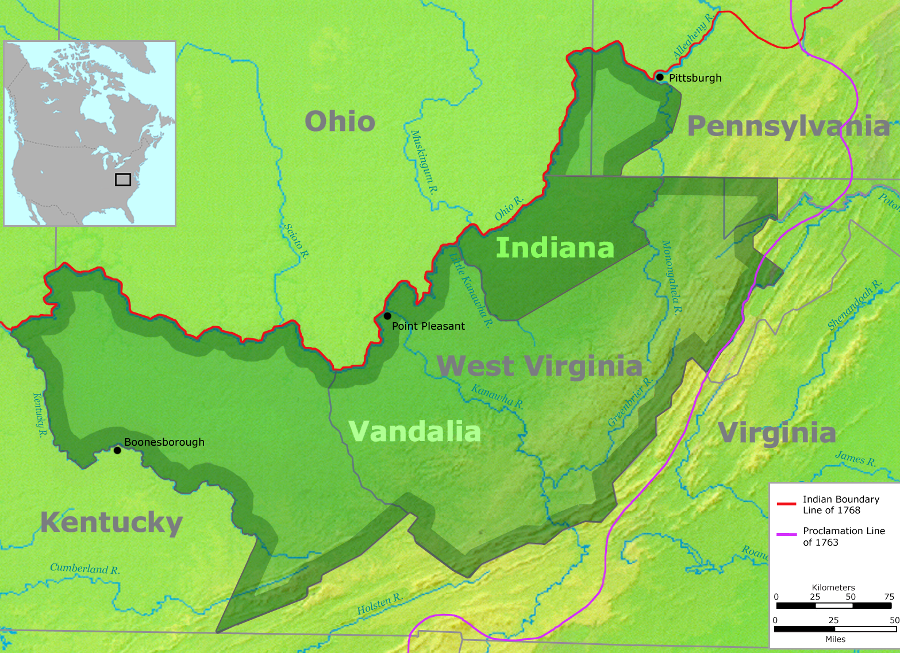
the "suffering traders" grant obtained in the 1768 Treaty of Fort Stanwix expanded by 1772 to the proposed 20,000,000 acre colony of Vandalia
Source: Wikipedia, Ohio Company
The investors in the Grand Ohio Company had succeeded. Investors who had backed other land companies, and had not consolidated their claims with the Walpoles, ended up with nothing.
The right to settle Vandalia also competed with land grants that the colony of Virginia already had promised. In 1754 Governor Dinwiddie had declared that 200,000 acres would be awarded to men who enlisted in the Virginia Regiment at the start of the French and Indian War.
In 1773 Governor Dunmore in Williamsburg decided to open a land office and approve surveys and patents in the disputed territory for those veterans. Since 1770 George Washington had been surveying parcels that could be claimed by military warrants based on French and Indian War service, which Washington had earned and also acquired from other soldiers.
Washington and Dunmore were racing to beat the creation of Westmoreland County by Pennsylvania officials and competing "official" surveys and patents authorized by that colony. Both colonies also were racing to beat claims of the Vandalia Company, which had great influence with the Privy Council in London.
Dunmore chose to ignore direction issued to colonial governors in 1773 by the Board of Trade to alter the land grant process. London officials mandated a new system designed to raise funds through the sale of lands at auction, after survey, and by the effective annual collection of quitrents (property taxes) from those who purchased parcels. Such funding would reduce the dependency of royal officials upon colonial legislators, increasing the ability to get the governors to enforce London's policies.
The colonial governors lacked the funds for identifying which lands had not already been granted, or authorized for sale through warrants and surveys which had not been finalized. Many settlers postponed the last step of obtaining a formal grant signed by the governor, which required paying a fee and triggered the requirement to pay annual quitrents. Dunmore was willing to keep processing the land transfers, citing the exemption in the Board of Trade guidance which exempted pre-existing claims from the new process.
In 1774 Lord Dunmore himself came to Fort Pitt. He commanded part of an army that forced the Shawnee to sign away their land claims south of the Ohio River, a deal formalized in the Treaty of Camp Charlotte. The Virginia governor directed Dr. John Connolly to occupy the site of Fort Pitt, which the British had destroyed when they abandoned it in 1772. Pennsylvania officials then arrested Connolly. After he was released from jail in Westmoreland County, Connolly brought 200 Virginia militia and seized control of Pittsburgh.7
However, plans for formalizing Vandalia faded as British officials focused on American rebelliousness in 1774-1775. Benjamin Franklin created a major problem when he was caught releasing private letters sent by the royal governor in Massachusetts. That breach of honor led to Franklin being forced to endure a one-hour diatribe at the Privy Council by Alexander Wedderburn on January 29, 1774.
Wedderburn was also the Solicitor General who had to complete the final steps required to formalize the Privy Council decision to approve the Grand Ohio Company grant. He had received the paperwork from Lord Dartmouth six months earlier. Wedderburn finally signed the necessary documents to finalize the Vandalia grant on May 1, 1775, but creation of a 14th colony was suspended until the unrest in North America could be resolved. Soon afterwards, news arrived in London of the fighting at Lexington and Concord.
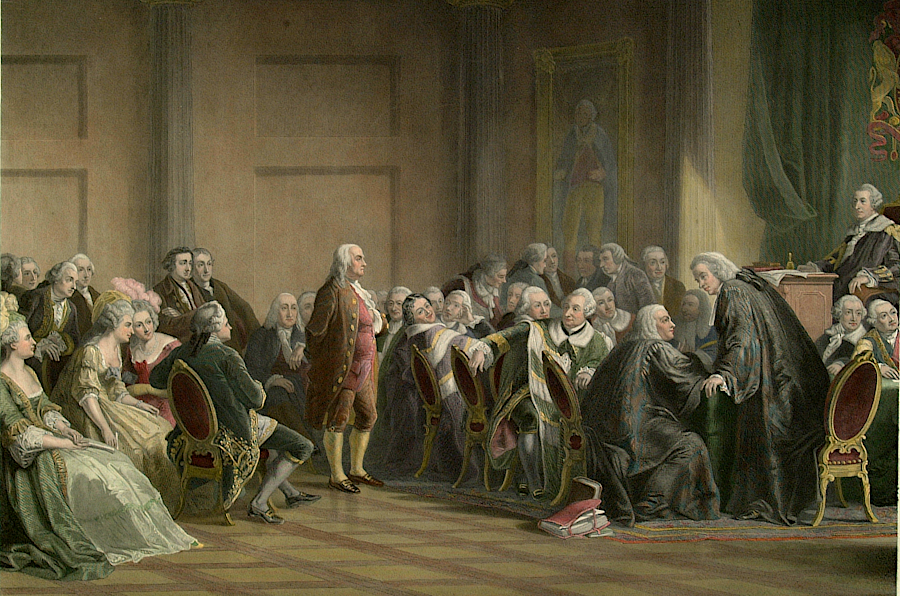
the Privy Council confronted Benjamin Franklin on January 29, 1774 for his support of rebellious Massachusetts, and the 20,000,000 acre grant for Vandalia was never finalized
Source: American Philosophical Society Library, Franklin before the Lords in Council, 1774
In addition to Wedderburn, by 1774 other British officials saw few benefits from creating Vandalia. Communities of land-hungry settlers west of the mountains would have little desire to obey royal policies expressed by the Superintendent for Indian Affairs for either the Northern Department or the Southern Department. The British sought to ally with the Native Americans as the colonists became rebels and revolutionaries, so authorizing colonists to intrude into western lands would have been counter-productive.
In 1775 William Trent tried "Plan B." He lobbied the Continental Congress in Philadelphia to approve acquisition of the original Indiana parcel. Despite offering shares of the Indiana Company as a bribe to eight delegates, he could not overcome the steady opposition by the influential Virginia delegation in the Continental Congress.
The Indiana Company reorganized, including the original investors, on March 20, 1776 in Philadelphia. Recognizing that a grant from British officials would no longer be recognized as valid, they tried to pressure the Continental Congress to formalize their rights to the original Indiana grant. That grant had been made by the Haudenosaunee to the suffering traders during negotiations for the 1768 Treaty of Fort Stanwix.
Delegates to the Continental Congress were pressured by other land companies for competing claims to western lands, and separate colonies claimed overlapping authority ove the Ohio River Valley. The delegates also knew that the western lands could be claimed by veterans granted land bounties in order to get men to enlist in the Continental Army, and those lands could be sold to generate revenue for the new national government.
Later in the 1780's, Samuel Wharton used his position in the Continental Congress to seek some sort of land grant based on the claims of the suffering traders. That effort failed.
The authority of the newly-independent states to approve grants was not resolved until 1784. The new national government was given that power when Virginia ceded its claim to the Northwest Territory. That cession made no provision for the various land companies with claims dating back to 1749.
Land speculators failed to get the new United States of America to approve old royal grants. Instead, military reserves were created to satisfy the land bounties promised to veterans, and the Northwest Territory was surveyed and sold by the national government.8
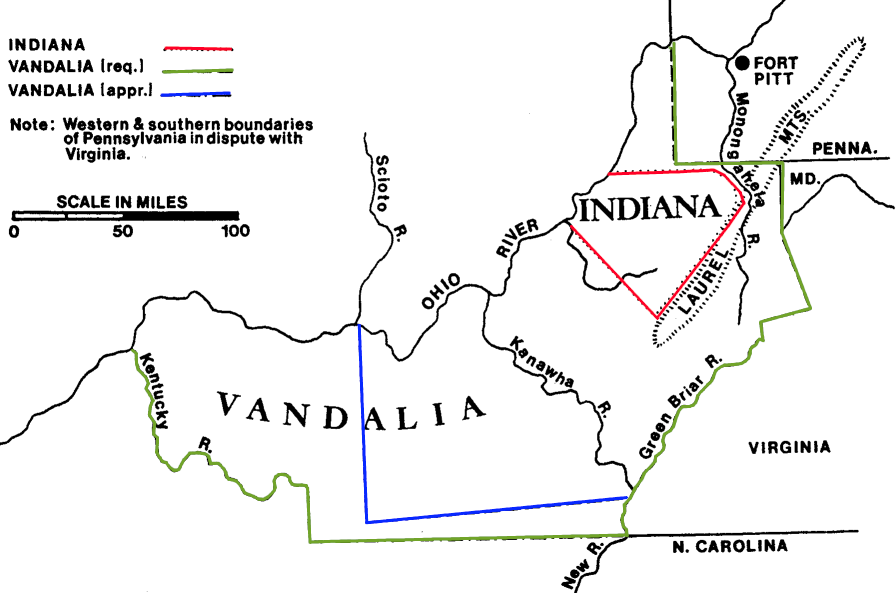
the proposed colony of Vandalia expanded far beyond the boundaries of the Indiana land claim
Source: Wikipedia, Ohio Company
George Croghan sold his share on the Indiana Company to two of the Wharton brothers at the end of 1768, so he managed to generate some revenue. Suffering traders who sold their claims for cash to William Trent or the Walpoles ended up being the only ones to benefit from the speculation. The Illinois Company, Indiana Company, Mississippi Company, and Grand Ohio Company/Vandalia Company sold no land, so their investors received no profits.9
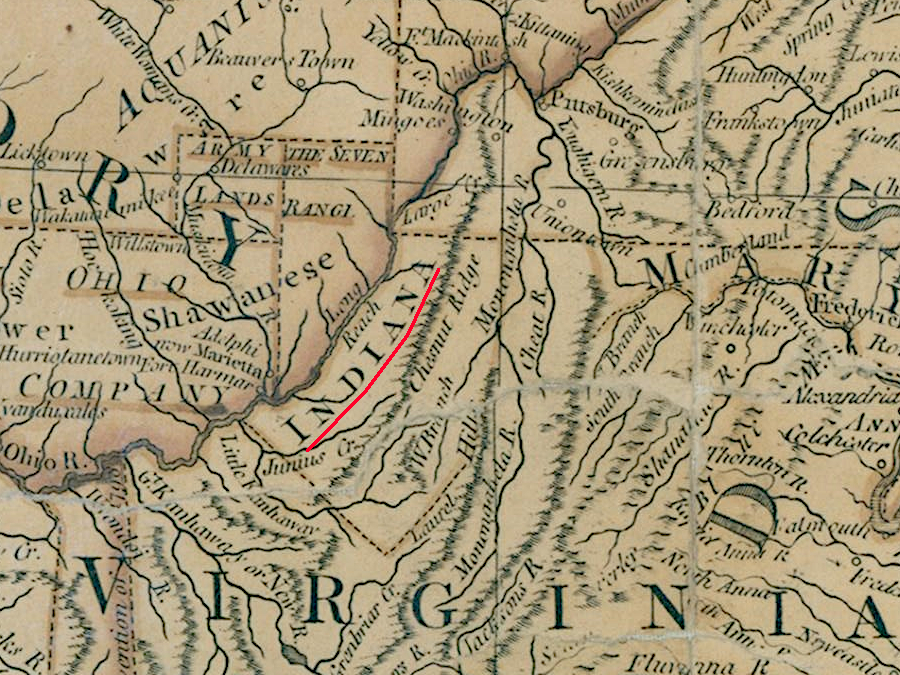
as late as 1793 the Indiana land claim was still being recorded on British maps
Source: National Archives, United States of North America with the British Territories and Those of Spain According to the Treaty of 1784 (1793)
"Vandalia" remains on the map today as a county in West Virginia. In 1863, the western counties of Virginia created a new state separate from the Restored Government of Virginia. One name proposed for the new state was Vandalia, before final adoption of the name West Virginia.10
Links
References
1. Barbara Rasmussen, Absentee Landowning and Exploitation in West Virginia, 1760-1920, University Press of Kentucky, 2015, pp.24-26, https://books.google.com/books?id=CK4eBgAAQBAJ; "Vandalia: The First West Virginia?," West Virginia History, West Virginia Archives and History, Volume 40, Number 4 (Summer 1979), https://archive.wvculture.org/history/journal_wvh/wvh40-4.html; George E. Lewis, The Indiana company, 1763-1798; a study in eighteenth century frontier land speculation and business venture, 1941, pp.39-44, https://babel.hathitrust.org/cgi/pt?id=uva.x000101098&seq=9 (last checked September 2, 2025)
2. "Vandalia: The First West Virginia?," West Virginia History, West Virginia Archives and History, Volume 40, Number 4 (Summer 1979), https://archive.wvculture.org/history/journal_wvh/wvh40-4.html; James D. Anderson, "Samuel Wharton and the Indians' Rights to Land: An Eighteenth-Century View," Western Pennsylvania Historical Magazine, Volume 63 (April 1980), pp.123-126, https://journals.psu.edu/wph/article/view/3645; George E. Lewis, The Indiana company, 1763-1798; a study in eighteenth century frontier land speculation and business venture, 1941, pp.45-53, https://babel.hathitrust.org/cgi/pt?id=uva.x000101098&seq=9 (last checked September 2, 2025)
3. "From Benjamin Franklin to Richard Jackson, 24 December 1763," Founders Online, National Archives, https://founders.archives.gov/documents/Franklin/01-10-02-0220 (last checked September 4, 2025)
4. James D. Anderson, "Samuel Wharton and the Indians' Rights to Land: An Eighteenth-Century View," Western Pennsylvania Historical Magazine, Volume 63 (April 1980), pp.127-131, https://journals.psu.edu/wph/article/view/3645; George E. Lewis, The Indiana company, 1763-1798; a study in eighteenth century frontier land speculation and business venture, 1941, pp.61-65, https://babel.hathitrust.org/cgi/pt?id=uva.x000101098&seq=9 (last checked September 4, 2025)
5. "Vandalia: The First West Virginia?," West Virginia History, West Virginia Archives and History, Volume 40, Number 4 (Summer 1979), https://archive.wvculture.org/history/journal_wvh/wvh40-4.html; "1768 Boundary Line Treaty of Fort Stanwix," National Park Service, https://www.nps.gov/articles/000/1768-boundary-line-treaty-of-fort-stanwix.htm; Jason A. Cherry, "Vandalia Colony: American Triumph or Folly?," Journal of the American Revolution, August 14, 2025, https://allthingsliberty.com/2025/08/vandalia-colony-american-triumph-or-folly/ (last checked August 31, 2025)
6. Barbara Rasmussen, Absentee Landowning and Exploitation in West Virginia, 1760-1920, University Press of Kentucky, 2015, pp.24-26, https://books.google.com/books?id=CK4eBgAAQBAJ; "Vandalia: The First West Virginia?," West Virginia History, West Virginia Archives and History, Volume 40, Number 4 (Summer 1979), https://archive.wvculture.org/history/journal_wvh/wvh40-4.html; James D. Anderson, "Samuel Wharton and the Indians' Rights to Land: An Eighteenth-Century View," Western Pennsylvania Historical Magazine, Volume 63 (April 1980), pp.132-137, https://journals.psu.edu/wph/article/view/3645; "Agreement to Admit the Ohio Company as Co-Purchasers with the Grand Ohio Company, 7 May 1770," Founders Online, National Archives, https://founders.archives.gov/documents/Franklin/01-17-02-0071; "The Founders and the Pursuit of Land," Lehrman Institute, https://lehrmaninstitute.org/history/founders-land.html; Jason A. Cherry," Vandalia Colony: American Triumph or Folly?," Journal of the American Revolution, August 14, 2025, https://allthingsliberty.com/2025/08/vandalia-colony-american-triumph-or-folly/; Stephen Carr Hampton, "On this date... June 1, 1773... Georgia," Memories of the People blog, June 1, 2014, https://memoriesofthepeople.blog/2014/06/01/on-this-date-june-1-1773-georgia/ (last checked November 22, 2025)
7. "Affairs In Virginia; The Indian Expedition," Lord Dunmore's official report to the Secretary of State Lord Dartmouth, December 24, 1774, in Reuben Gold Thwaites, Documentary history of Dunmore's war, 1774 , Wisconsin Historical Society, 1905, p.370, https://archive.org/details/documentaryhist00thwarich; "Vandalia: The First West Virginia?," West Virginia History, West Virginia Archives and History, Volume 40, Number 4 (Summer 1979), https://archive.wvculture.org/history/journal_wvh/wvh40-4.html; "Lord Dunmore's War," Heinz History Center, https://www.heinzhistorycenter.org/blog/fort-pitt-museum-lord-dunmores-war/; "The Founders and the Pursuit of Land," Lehrman Institute, https://lehrmaninstitute.org/history/founders-land.html; St. George L. Sioussat, "The Breakdown of the Royal Management of Lands in the Southern Provinces, 1773-1775," Agricultural History, Volume 3, Number 2 (April, 1929), pp.81-82, https://www.jstor.org/stable/3739789 (last checked November 22, 2025)
8. James D. Anderson, "Samuel Wharton and the Indians' Rights to Land: An Eighteenth-Century View," Western Pennsylvania Historical Magazine, Volume 63 (April 1980), pp.132-137, https://journals.psu.edu/wph/article/view/3645; "Editorial Note on the Reorganization of the Indiana Company, 19 January 1776 to 20 March 1776," Founders Online, National Archives, https://founders.archives.gov/documents/Franklin/01-22-02-0197; Jason A. Cherry," Vandalia Colony: American Triumph or Folly?," Journal of the American Revolution, August 14, 2025, https://allthingsliberty.com/2025/08/vandalia-colony-american-triumph-or-folly/; Charles Greifenstein, "How Alexander Wedderburn Cost England America," American Philosophical Society, January 9, 2018, https://www.amphilsoc.org/blog/how-alexander-wedderburn-cost-england-america (last checked August 31, 2025)
9. "Vandalia: The First West Virginia?," West Virginia History, West Virginia Archives and History, Volume 40, Number 4 (Summer 1979), http://www.wvculture.org/HISTORY/journal_wvh/wvh40-4.html (last checked August 16, 2016)
10. "What's in a name? The origin of 'West Virginia'... and what the state might have been called instead," West Virginia Tourism Office, https://wvtourism.com/whats-name-origin-west-virginia-state-might-called-instead/ (last checked June 22, 2019)
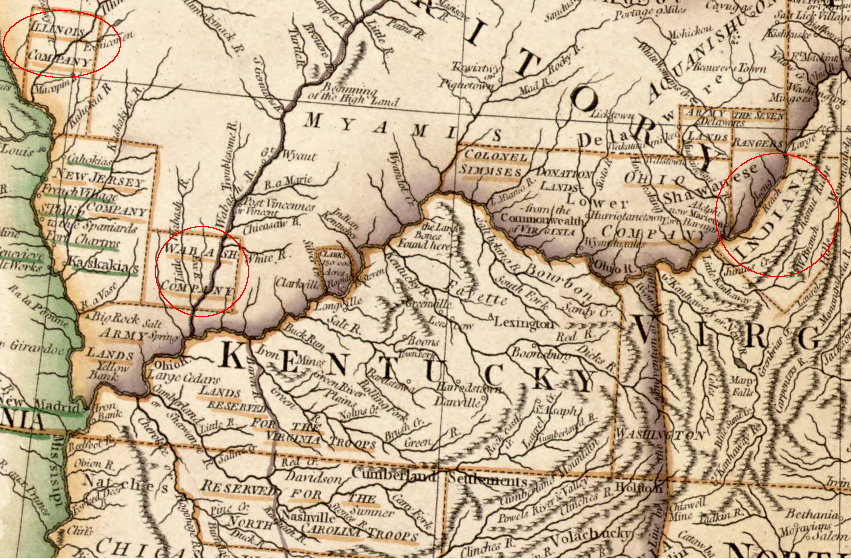
in the 1790's, the Federal government sold large parcels of the public land north of the Ohio River to land speculators
Source: Library of Congress, The United States of North America, with the British territories (William Faden, 1793)
Exploring Land, Settling Frontiers
Virginia Places






